[English] 日本語
 Yorodumi
Yorodumi- PDB-2kln: Solution Structure of STAS domain of RV1739c from M. tuberculosis -
+ Open data
Open data
- Basic information
Basic information
| Entry | Database: PDB / ID: 2kln | ||||||
|---|---|---|---|---|---|---|---|
| Title | Solution Structure of STAS domain of RV1739c from M. tuberculosis | ||||||
 Components Components | PROBABLE SULPHATE-TRANSPORT TRANSMEMBRANE PROTEIN, COG0659 | ||||||
 Keywords Keywords | TRANSPORT PROTEIN / SLC26 / Sulfate / SulP / AntiSigma Factor Antagonist / ensemble of 25 structures / Membrane / Transmembrane | ||||||
| Function / homology | STAS domain / Transcription Regulator spoIIAA / 2-Layer Sandwich / Alpha Beta / :  Function and homology information Function and homology information | ||||||
| Biological species |  Mycobacterium bovis (bacteria) Mycobacterium bovis (bacteria) | ||||||
| Method | SOLUTION NMR / torsion angle dynamics, DGSA-distance geometry simulated annealing | ||||||
 Authors Authors | Sharma, A.K. / Ye, L. / Zolotarev, A.S. / Alper, S.L. / Rigby, A.C. | ||||||
 Citation Citation |  Journal: J.Biol.Chem. / Year: 2011 Journal: J.Biol.Chem. / Year: 2011Title: Solution Structure of the Guanine Nucleotide-binding STAS Domain of SLC26-related SulP Protein Rv1739c from Mycobacterium tuberculosis. Authors: Sharma, A.K. / Ye, L. / Baer, C.E. / Shanmugasundaram, K. / Alber, T. / Alper, S.L. / Rigby, A.C. | ||||||
| History |
|
- Structure visualization
Structure visualization
| Structure viewer | Molecule:  Molmil Molmil Jmol/JSmol Jmol/JSmol |
|---|
- Downloads & links
Downloads & links
- Download
Download
| PDBx/mmCIF format |  2kln.cif.gz 2kln.cif.gz | 1.1 MB | Display |  PDBx/mmCIF format PDBx/mmCIF format |
|---|---|---|---|---|
| PDB format |  pdb2kln.ent.gz pdb2kln.ent.gz | 949.7 KB | Display |  PDB format PDB format |
| PDBx/mmJSON format |  2kln.json.gz 2kln.json.gz | Tree view |  PDBx/mmJSON format PDBx/mmJSON format | |
| Others |  Other downloads Other downloads |
-Validation report
| Summary document |  2kln_validation.pdf.gz 2kln_validation.pdf.gz | 345.5 KB | Display |  wwPDB validaton report wwPDB validaton report |
|---|---|---|---|---|
| Full document |  2kln_full_validation.pdf.gz 2kln_full_validation.pdf.gz | 577.5 KB | Display | |
| Data in XML |  2kln_validation.xml.gz 2kln_validation.xml.gz | 73.9 KB | Display | |
| Data in CIF |  2kln_validation.cif.gz 2kln_validation.cif.gz | 97.4 KB | Display | |
| Arichive directory |  https://data.pdbj.org/pub/pdb/validation_reports/kl/2kln https://data.pdbj.org/pub/pdb/validation_reports/kl/2kln ftp://data.pdbj.org/pub/pdb/validation_reports/kl/2kln ftp://data.pdbj.org/pub/pdb/validation_reports/kl/2kln | HTTPS FTP |
-Related structure data
| Similar structure data | |
|---|---|
| Other databases |
- Links
Links
- Assembly
Assembly
| Deposited unit | 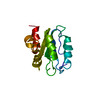
| |||||||||
|---|---|---|---|---|---|---|---|---|---|---|
| 1 |
| |||||||||
| NMR ensembles |
|
- Components
Components
| #1: Protein | Mass: 15093.152 Da / Num. of mol.: 1 / Fragment: residues 437-560 Source method: isolated from a genetically manipulated source Source: (gene. exp.)  Mycobacterium bovis (bacteria) / Gene: Mb1768c, Rv1739c / Plasmid: pETBlue-1 / Production host: Mycobacterium bovis (bacteria) / Gene: Mb1768c, Rv1739c / Plasmid: pETBlue-1 / Production host:  |
|---|
-Experimental details
-Experiment
| Experiment | Method: SOLUTION NMR | ||||||||||||||||||||||||||||||||||||||||||||||||||||||||||||||||||||||||||||||||||||||||
|---|---|---|---|---|---|---|---|---|---|---|---|---|---|---|---|---|---|---|---|---|---|---|---|---|---|---|---|---|---|---|---|---|---|---|---|---|---|---|---|---|---|---|---|---|---|---|---|---|---|---|---|---|---|---|---|---|---|---|---|---|---|---|---|---|---|---|---|---|---|---|---|---|---|---|---|---|---|---|---|---|---|---|---|---|---|---|---|---|---|
| NMR experiment |
|
- Sample preparation
Sample preparation
| Details |
| ||||||||||||||||||||||||||||||||||||||||||||||||||||||||||||||||||||||||||||
|---|---|---|---|---|---|---|---|---|---|---|---|---|---|---|---|---|---|---|---|---|---|---|---|---|---|---|---|---|---|---|---|---|---|---|---|---|---|---|---|---|---|---|---|---|---|---|---|---|---|---|---|---|---|---|---|---|---|---|---|---|---|---|---|---|---|---|---|---|---|---|---|---|---|---|---|---|---|
| Sample |
| ||||||||||||||||||||||||||||||||||||||||||||||||||||||||||||||||||||||||||||
| Sample conditions | Ionic strength: 275 / pH: 7.2 / Pressure: ambient / Temperature: 298 K |
-NMR measurement
| NMR spectrometer | Type: Bruker Avance / Manufacturer: Bruker / Model: AVANCE / Field strength: 600 MHz |
|---|
- Processing
Processing
| NMR software |
| ||||||||||||||||||||||||||||||||||||||||||||
|---|---|---|---|---|---|---|---|---|---|---|---|---|---|---|---|---|---|---|---|---|---|---|---|---|---|---|---|---|---|---|---|---|---|---|---|---|---|---|---|---|---|---|---|---|---|
| Refinement | Method: torsion angle dynamics, DGSA-distance geometry simulated annealing Software ordinal: 1 | ||||||||||||||||||||||||||||||||||||||||||||
| NMR representative | Selection criteria: lowest energy | ||||||||||||||||||||||||||||||||||||||||||||
| NMR ensemble | Conformer selection criteria: structures with the lowest energy Conformers calculated total number: 400 / Conformers submitted total number: 25 |
 Movie
Movie Controller
Controller



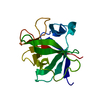

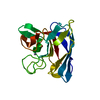
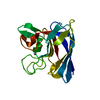


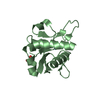
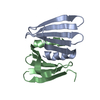
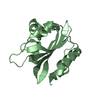
 PDBj
PDBj HSQC
HSQC